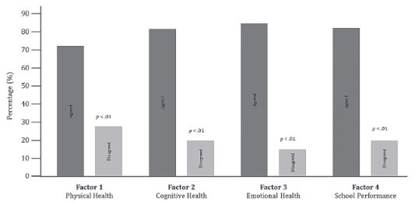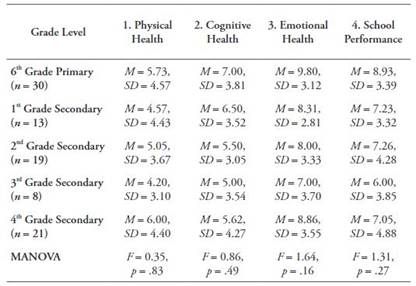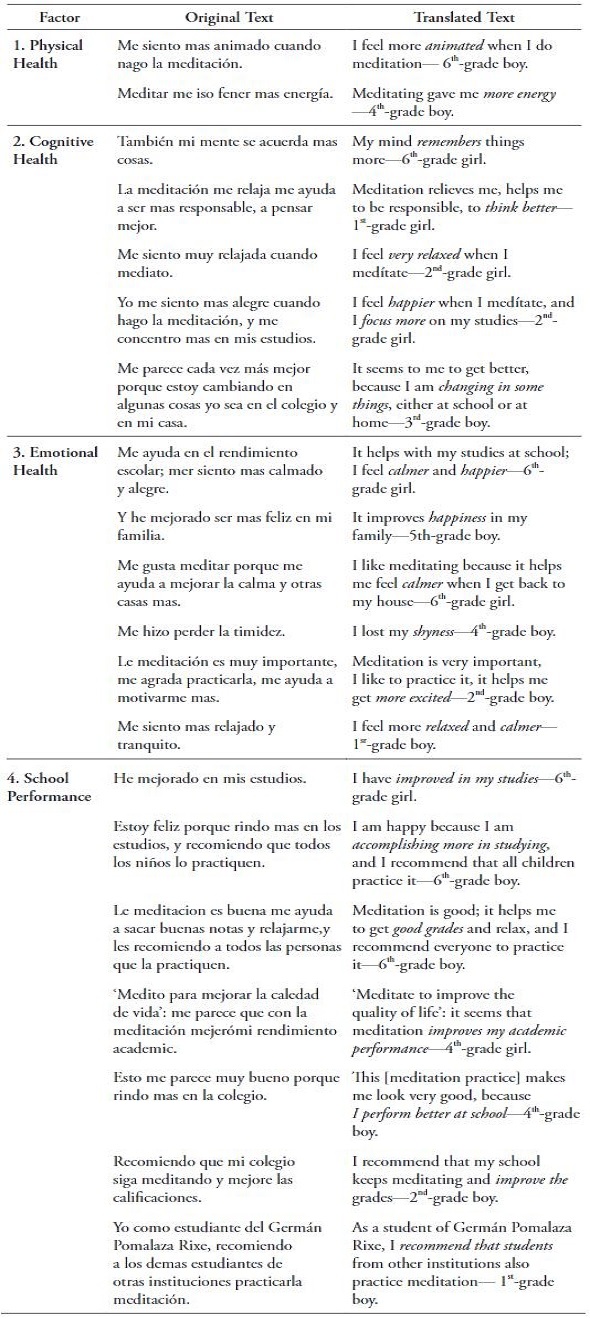1. Introduction and theoretical framework
Despite having been taught and practiced in Latin America for several decades, and despite its thorough investigation since the 1970s, the Transcendental Meditation technique as an educational aid has until recently not been the subject of rigorous or sustained research in western hemisphere countries other than Canada and the United States. This study seeks to begin addressing this evidentiary shortfall.
The uniqueness of the setting in remote Perú to explore the experiences of school children makes the research doubly relevant. Indeed, of the more than 500 published studies on Transcendental Meditation, less than five percent have been conducted in minority or indigenous communities, and few have considered sustained research in educational settings beyond the borders of Europe and the United States, although a comprehensive research program has been conducted in Cambodia by these authors since the mid-1990s (Fergusson & Bonshek, 2017).
An extensive corpus of published research on Transcendental Meditation, a simple and natural mental technique for engendering restful alertness and deep rest and overcoming stress (Maharishi Foundation International, 2014), began appearing in the academic literature on physiology, neurophysiology, psychology, and sociology in the mid-1970s (Orme-Johnson & Farrow, 1977). Since then, another seven volumes of collected research papers have been published covering a wide range of specialist topics, such as metabolism, biochemistry, electrophysiological and electroencephalographic changes, perceptual and motor abilities, cardiovascular changes, health and education, productivity, and quality of life (Chalmers et al., 1989a, 1989b, 1989c; Dillbeck, 2011, 2013, 2020; Wallace, Orme-Johnson, & Dillbeck, 1990). Many of these prior investigations used a paper-and-pencil, survey-type questionnaire similar to the one used in this present study.
However, most of these data are understandably drawn from adults and not children. In this study, we discuss research outcomes associated with primary and secondary students in two main areas of educational interest: 1) physical, cognitive, and emotional health; and 2) school performance, including academic achievement and learning. Consideration of regularity of practice in Transcendental Meditation is also a question of interest because recent findings suggest that students who practice the technique more regularly also have higher levels of resilience (Wendt et al., 2015).
Table 1 Summary of international research findings and authors related to health and school performance.
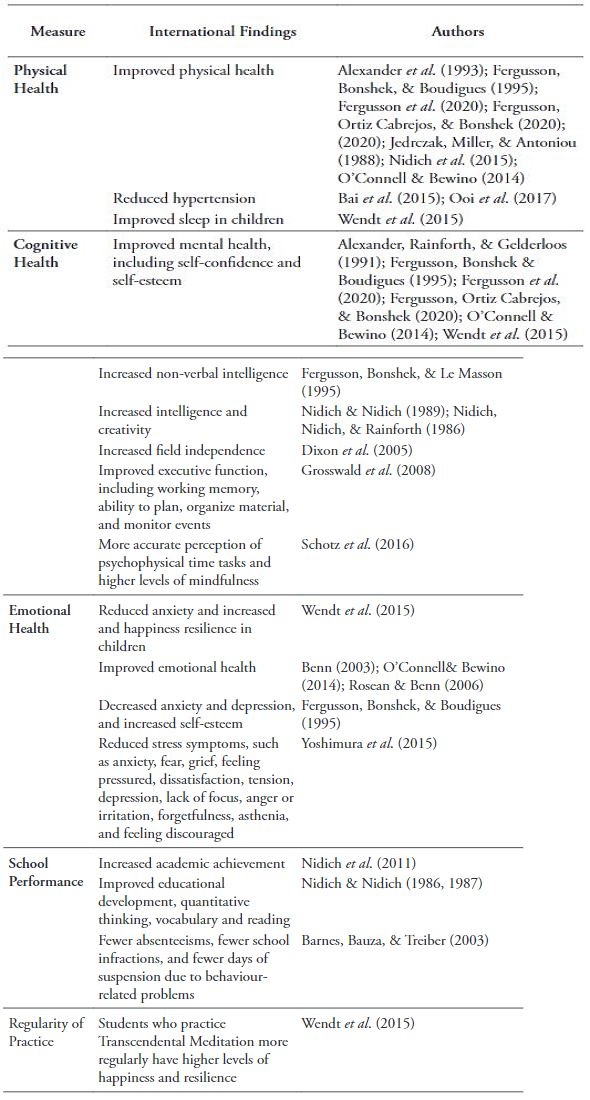
Rosaen and Benn’s (2006) work with 7th-grade students who practiced Transcendental Meditation for one year encapsulates this overall research effort because they found children practitioners had an increased state of restful alertness, improved academic performance, and skills indicative of greater emotional intelligence. The state of restful alertness induced by meditation, according to these authors, appeared central to facilitating growth in socio-emotional capacities, academic performance, and flexibility in emotional response. According to the researchers, restful alertness provided students with greater capacity to expand their ways of looking inwardly at themselves and their relationships with others, as well as focusing their attention on controlling their behaviour and keeping on task in school.
Data gathered over many decades explain the relationship of Transcendental Meditation to physical health (e.g., Alexander et al., 1993; Jedrczak et al., 1988; Nidich et al., 2015), a topic recently explored in the context of contemporary medical care (O’Connell & Bevvino, 2014). For example, in controlled research, Fergusson and others studied the impact of Transcendental Meditation on the physical health (Fergusson, Bonshek and Boudigues, 1995) and non-verbal intelligence (Fergusson, Bonshek, & Le Masson, 1995) of Cambodian university students, and more recently Fergusson et al. (2020) found evidence for an improved state of physical and mental health in young university faculty and staff in Cambodia. Evidence also suggests that practice of Transcendental Meditation is associated with lower levels of hypertension (Bai et al., 2015; Ooi et al., 2017), a subject of previous investigation in Junín, Perú (Romero et al., 2014).
Nidich, Nidich and others (1986, 1987) reported findings associated with increased IQ scores for students in 4th-12th grades who meditate, as well as increased creativity for 5th-8th graders when compared to controls, a finding replicated by the same authors (Nidich & Nidich, 1989; Nidich et al., 1986) and by others using instruments such as the Children’s Embedded Figures Test and Ravens Progressive Matrices Test (Dixon et al., 2005). Schötz et al. (2016) found that practitioners of Transcendental Meditation performed more accurately on psychophysical time perception tasks and had higher mindfulness than non-meditating controls. Alexander et al. (1991) have provided a conceptual overview and meta-analysis of data related to psychological health, and Benn (2003) has found that 5th-grade students who practiced Transcendental Meditation for three months showed less worry and anxiety than a control and displayed higher levels of emotional intelligence and affect.
Grosswald et al. (2008) similarly investigated the role of Transcendental Meditation in managing attention deficit hyperactivity disorder (ADHD) in 6th-9th grade students who meditated for three months and detected a significant decrease in stress, anxiety, and ADHD symptoms, and an improvement in executive function, including working memory, ability to plan, organize material, and monitor events. Yoshimura et al. (2015) even found reduced stress symptoms in Japanese disaster victims, such as anxiety, fear, grief, feelings of pressure, dissatisfaction, tension, depression, lack of focus, anger and irritation, forgetfulness, asthenia, and feeling discouraged, suggesting a potential value through Transcendental Meditation for relief from disaster trauma.
Wendt et al. (2015) observed a range of psychological benefits from the practice in a group of U.S. students, 25% of whom were Hispanic or Latino. For example, in a large-scale controlled longitudinal study, the authors found Transcendental Meditation apparently reduced a student’s level of anxiety and increased their level of resilience, as measured by one’s “emotional capability to cope with stress and adversity” (p. 314). Nidich et al. (2011) investigated the impact of Transcendental Meditation in a controlled longitudinal study of academic achievement in at-risk 6th-, 7th- and 8th-grade students in a low socioeconomic school using the California Standards Test to measure changes in Mathematics and English language scores. The authors reported that meditating students after one year of practice scored significantly higher on scales of Mathematics and English when compared to controls.
Nidich and others (1986, 1987) had earlier reported that students who practiced Transcendental Meditation perform better on standardized tests than their peers in mathematics, reading and language skills (in one study on 3rd-8th graders), and on a range of developmental skills, including improved academic performance, educational development in correctness of expression, quantitative thinking, social and natural sciences, general vocabulary, and reading (in a separate study on 9th-12th graders). Barnes et al. (2003), using the Spielberger Anger Expression Scale, found that meditating 15- to 18-year-old children had fewer absenteeism, fewer school infractions, and fewer days of suspension due to behavior-related problems than did a control group.
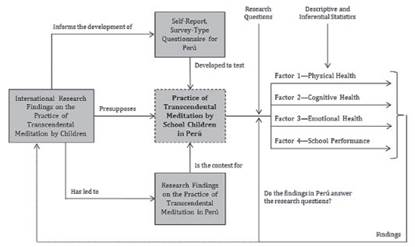
Figure 1 Proto-theoretical research model for investigating the practice of Transcendental Meditation by school children in Perú.
Recent qualitative research using a learning history model by these authors has investigated the third-party perceptions of parents and teachers of Aymara students and their practice of Transcendental Meditation in Puno, Perú (Fergusson, Ortiz Cabrejos, & Bonshek, 2021). This study indicated the experiences of students largely confirmed or augmented previous findings on Transcendental Meditation from other international educational settings, but in some cases actually uncovered new areas of knowledge about student experience, such as students may develop ambition through the practice but such ambition is not associated with greed. Furthermore, research indicated that the long-term practice of Transcendental Meditation by Aymara in Puno affirmatively impacted life over an average of 15 years in the areas of consciousness, mental health, physical health, behavior, and sociocultural dimensions (Fergusson, Ortiz Cabrejos, & Bonshek, 2020). These international and Peruvian findings have been summarized in Table 1.
Figure 1 presents the proto-theoretical research model guiding the present study. The findings of prior research have informed the development of the research instrument to be used in Perú and have led to the recent investigations in Perú, where upwards of 50,000 students and teachers have been instructed in Transcendental Meditation since 2000. As a result, we advance two research questions with a view to exploring the self-reported impact of Transcendental Meditation on four factors of interest to educators: RQ1) Do students in Perú report that Transcendental Meditation has a salutary effect on health and school performance, and if so, are these effects influence by gender or grade level; and RQ2) If there is an effect, is it related to the regularity with which students practice Transcendental Meditation? Results from Perú are expected to add to the accumulating international evidence on Transcendental Meditation and its possible role in primary and secondary education.
2. Materials and methods
This research project was approved in October 2019 by the Research Ethics Approval Committee of Maharishi Vedic Research Institute (MVRI) in Australia, in accord with both MVRI’s Code of Research Practice and Procedure and the Australian Code for the Responsible Conduct of Research and was conducted under approval number: MVRI-2019-19. The project was countenanced in advance by administrators of German Pomalaza Rixe and Instituto Maharishi de Ciencia y Tecnología del Perú.
I. Setting. The site chosen for this research project was Huay-Huay. Founded in 1960, Huay-Huay is one of ten districts in Yauli province in the Junín region of central Perú. The town (11° 4’ 35” S, 76° 23’ 57” W), located high in the Andean tundra at an altitude of 4,590 m, had a population of approximately 2,040 in 2019 when this study was carried out. Huay-Huay has a 95% literacy rate and is home to 82% Mestizo and 15% Quechua people (a pre-Incan people associated with the Aymara of southern Perú), 80% of whom are Roman Catholic. One of the distinct features of Huay-Huay is its climate: remaining cold throughout the year, average temperatures range from lows of 0°C (32°F) to highs of just 10°C (50°F).
The Junin region of Perú has been well documented for its distinctive flora and natural resources. For example, Brinckmann and Smith (2004) considered the cultural importance of the maca root to the Quechua, a cultivated crop only found on the Andean central sierra of Junín and Pasco above 4,000 m; Robdell et al. (2014) examined the impact of mining and acid mine drainage on regional rivers and streams; and Luziatelli et al. (2010, p. 1) explored the medicinal plants of the Asháninka Native Community Bajo Quimiriki, noting that Perú is “one of the twelve most biodiversity rich, or ‘mega-diverse’, countries of the world”. Romero et al. (2014, p. 78) have also documented the prevalence of hypertension and obesity in the region and issued a “call to be aware of the situation of chronic non-communicable diseases in indigenous populations”.
In Perú, primary and secondary education are mandatory. Primary education consists of six years of schooling for students between the ages of six and 11; secondary education, for students between the ages of 12-16, consists of five-year block divided into two cycles, with the majority of schools offering the same block to all students. In the first two-year cycle, the curriculum is general and uniform for all students; in the second three-year cycle, students choose between courses in science, humanities or technology. In 2015, total enrolment in primary and secondary education was in excess of 7.5 million students; in the Junín region 153,706 students were enrolled in primary education and 116,705 students were enrolled in secondary education (Ministerio de Educación, 2017).
The Transcendental Meditation technique, introduced to Huay-Huay in 2018 by Instituto Maharishi de Ciencia y Tecnología del Perú, is described as a mental procedure practiced for 15 minutes twice a day by students while sitting comfortably with eyes closed. The technique does not require changes to personal belief, lifestyle, religion, or philosophy. Moreover, no mental effort is required to intentionally alter physiological or psychological processes or states, making it fundamentally different to mindfulness and other mental techniques which advocate concentration or mind control. However, the ordinary thinking process does become quiet and a distinct state of psychophysiological restful alertness, a wakeful but deeply restful state, is naturally gained. Experience of such a restful state has been attributed to the range of health benefits previously observed in children and adults.
II. Research Design. This cross-sectional study used an observational design without a control group, and thus does not seek to statistically measure ‘change’ or ‘impact’ in participant views (Boyko, 2013). No manipulation of variables has occurred and therefore no attribution of cause has been made to Transcendental Meditation practice as a result of this design. Rather, observational research of this type is often used to “provide preliminary data to justify the performance of a clinical [randomized controlled] trial, which might not have received sufficient funding support without the existence of such results” and has “value in assessing a potential causal relationship” (p. 643), as was the case with the present study. The design therefore seeks to explore whether students self-attribute health and school performance benefit to Transcendental Meditation and whether or not a correlation between regularity of practice and health and school performance can be identified. Thus, while the potential presence of a correlation does not imply causation, “causal associations will always involve correlation” (p. 643) and hence the need for this exploratory, observational study.
III. Participants. Huay-Huay hosts several schools, with the educational setting for this study being the primary and secondary school German Pomalaza Rixe (GPR), which is subject to accreditation by Unidad Ejecutora de Educacíon of the Ministerio de Educación (Ministry of Education). In any given year, GPR has a total of approximately 250 students. Over the course of three years, 2017-2019, 450 students were taught Transcendental Meditation at GPR. Of these, 91 students (or 20% of the total number of GPR students who had been taught Transcendental Meditation to that date at GPR) were randomly selected to participate in this study. Thus, students in the sample may have been meditating for between six months and two years. Of these, 40/44% were girls (M = 13.5 years, SD = 1.7) and 51/56% were boys (M = 13.6 years, SD = 1.6). At the time of investigation, no statistically significant difference between the ages of girls and boys was observed (t = 0.26, p = .39). Five grade levels were represented in the sample: 6th grade primary (n = 30/33%, M = 11.7 years, SD = 0.4); 1st grade secondary (n = 13/14%, M = 12.8 years, SD = 0.4); 2nd grade secondary (n = 19/21%, M = 13.8 years, SD = 0.4); 3rd grade secondary (n = 8/9%, M = 14.6 years, SD = 0.5); and 4th grade secondary (n = 21/23%, M = 15.8 years, SD = 0.4).
IV. Instrumentation. A paper-and-pencil questionnaire was developed by the second author. The Spanish-language questionnaire consisted of 47 dichotomous questions, requiring a self-reported ‘Agreed’ or ‘Disagreed’ answer. The 47 questions were clustered into four main factors: Factor 1-Physical Health; Factor 2-Cognitive Health; Factor 3-Emotional Health; and Factor 4-School Performance. The first three Factors were associated with functional health, and the last associated with academic performance and learning. Each of these four Factors was identified as relevant for school children in Perú (Adler, 2016) and the development of questions was informed by international research findings using the lines-of-inquiry and research protocol method outlined by Fergusson et al. (2019); such quantitative techniques are appropriate in observational research (Girard & Cohen, 2016). The earlier work of Benn (2003) and Rosaen and Benn (2006) informed the identification of key measurable variables in school children, but space disallows a fulsome description and definition of each Factor.
Factor 1-Physical Health. Factor 1 included 13 questions related to physical health, with students asked to rate their tiredness, energy, sickness, quality of sleep, and athletic ability because of practicing Transcendental Meditation. The importance of physical health and its promotion and place in well-balanced primary and secondary curricula has been the subject of extensive research and is generally accepted throughout the world as central to a child’s education. For example, Kronholm et al. (2015) have shown a relationship between sleep, tiredness, and school performance, and Hills et al. (2014) point out that declines in physical activity in children can lead to overweight, obesity, and other health-related problems in children.
Factor 2-Cognitive Health. Factor 2 included 10 questions related to cognitive health, with students asked to rate their memory, comprehension, and problem-solving ability because of practicing Transcendental Meditation. Physical activity in children is associated with brain functioning and cognitive health, including working memory, episodic memory, sustained attention, and processing speed (Geertsen et al., 2016), and cognitive health is associated with school performance (Liu et al., 2015).
Factor 3-Emotional Health. Factor 3 included 12 questions related to emotional health, with students asked to rate their aggression, affective relations, friendliness, and happiness because of practicing Transcendental Meditation. Research has established links between a child’s emotional health and their social and psychological well-being (Thompson et al., 2017).
Factor 4-School Performance. Factor 4 included 12 questions related to academic and general performance at school, with students asked to rate their satisfaction at school, efficiency, getting along better with classmates, academic achievement, and truancy because of practicing Transcendental Meditation. School performance is a multi-faceted measure and can incorporate academic elements such as grades and exam results, but also includes skills and strategies, and is associated with life satisfaction in children (Ng et al., 2015).
Regularity of Practice. Students were asked to report on the regularity with which they practiced Transcendental Meditation since being instructed, with options being: 1) ‘twice a day’, which is the recommended daily routine (scored as 5); 2) ‘once a day’ (scored as 4), 3) ‘from time-to-time’ (scored as 3); 4) ‘when required’ (scored as 2); and ‘never’ (scored as 1). As noted above, regularity of practice has been associated with higher levels of childhood resilience.
Supplementary Student Comments. Students were given an opportunity to record extemporaneous comments and reflections on their personal experiences with Transcendental Meditation. Where appropriate, these qualia will be reported as supplementary evidence to illuminate quantitative data on the Factors.
V. Procedure. Data collection occurred in November 2019 and was carried out in one session by the second author. The data were coded in the following way: A) all 47 dichotomous questions were scored ‘1’ for Agreed and ‘0’ for Disagreed in order to compute mean square contingency coefficients; and B) the sum of all ‘Agreed’ and ‘Disagreed’ dichotomous scores for the 13 questions which make up the physical health Factor 1, for example, were summed to produce the four interval Factor scores.
VI. Data Analysis. To answer RQ1, multivariate analyzes of variance (MANOVA) were conducted to test the difference between the sum of all Agreed responses and the sum of all Disagreed responses for each of the four Factors. MANOVA are suitable tests of difference between two sets of normally distributed scores, including when data are not normally distributed according to skewness, provided outliers have been removed (Rencher, 2002). The multiple Factors in the MANOVA were the dependent variables and the Agreed-Disagreed response category (i.e., grouping) was the independent variable in the regression model. MANOVA were performed to test if there was a statistically significant difference between girls and boys, and between grade levels. These analyzes were cross-tested using Cohen (d ) effect sizes to test for practical significance between the two response categories.
Three types of correlational analysis were performed: 1) mean square contingency coefficients (φ), or Phi coefficients, for correlations between the 47 dichotomous variables; 2) point biserial coefficients (r pb ) for correlations between dichotomous variables and linear Factors (i.e., the combined scores of dichotomous questions); and 3) Pearson product moment coefficients (r) for correlations between Factors and, to answer RQ2, between regularity of practice and Factors. All measures were analyzed using SPSS 26 and tested at the two-tailed level with greater than 99% level of confidence.
3. Results
Cronbach alpha coefficients computed for scale reliability of questions within Factors and Factors in relation to each other and to the overall construct (i.e., the combined score of all Factors) yielded internal consistencies of α = .52, α = .60, α = .55, and α = .62 for Factors 1, 2, 3, and 4, respectively, and α = .81 (i.e., the average reliability between Factors) and α = .86 (reliability for all Factors combined). Normality analysis indicated data for each Factor ranged from a low F1 = Skew [‒0.1], Kurt [‒0.1] to a high F3 = Skew [‒1.1], Kurt [1.5]; no outliers were observed.
The total scores of Agreed and Disagreed responses were tabulated and are shown in Figure 2. Seventy-three percent of students agreed and 27% disagreed that the practice of Transcendental Meditation had improved their physical health. Similarly, 81% and 86% respectively agreed the practice had positively impacted their cognitive and emotional health, with 19% and 14% disagreeing. Eighty-two percent of students agreed that Transcendental Meditation improved their performance at school, while 18% did not. A higher score on each Factor indicates a higher level of self-reported physical health, cognitive health, emotional health, and school performance.
As shown in Table 2, the difference between these scores was statistically significant to p < .01. Age, grade levels, and gender were not controlled as confounding variables as no difference was observed between them, as shown in Tables 3 and 4.
Table 2 also presents the effect sizes between the two dichotomous categories for Factors, indicating large effect sizes of between d = 1.8 and d = 3.5.
As shown in Table 3, there was no statistically significant difference between the scores of girls and boys. Effect sizes were small for Factors 2, 3, and 4, with no effect for Factor 1, thus indicating little or no practically significant difference in ratings due to gender.
Similarly, as shown in Table 4, there was no statistically significant difference between the scores of grade levels.
Mean square contingency analysis of the 47 dichotomous questions at p< .01 indicated that each of the 13 questions in Factor 1 were relatively weak predicators of physical health. For example, Q2 on improved physical capability correlated with Q3 increased energy (φ = .38) and Q13 athleticism (φ = .34) but not with other Factor 1 questions. Similarly, Q3 on increased energy was correlated with Q7 alertness and wakefulness (φ = .33) but not with other Factor 1 questions. Notwithstanding the overall findings in Table 5, dichotomous Factor 1 questions did not relate consistently with individual questions in Factors 2, 3, or 4.
However, strong and consistent correlations at p < .01 were observed within and between questions of the other three Factors. For example, Q1 in Factor 3 on improved interpersonal relations was correlated with Factor 2 questions, such as Q1 improved memory recognition (φ = .52), Q3 ability to study (φ = .35), Q4 improved comprehension (φ = .53), and Q7 increased enthusiasm (φ = .39). Similarly, Q5 in Factor 2 on generating more original ideas was correlated with Factor 3 questions, such as Q3 greater persistency (φ= .28), Q6 more affectionate relations (φ = .37), Q7 increased trust in oneself (φ = .26), Q9 increased decisiveness (φ = .38), Q10 feeling satisfied (φ = .33), and Q11 feelings of happiness (φ = .28). A clear overall pattern of correlations was also visible in the data between Factors 2 and 3.
Table 5 Pearson product moment correlation coefficients for Factors and regularity of practice (N = 91).
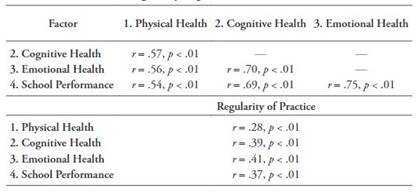
Dichotomous questions in Factor 4 likewise correlated at p < .01 with Factors 2 and 3. For example, Q5 in Factor 4 on getting along better with classmates was correlated with Factor 2 questions, such as Q1 improved memory recognition (φ = .30), Q2 improved recall (φ = .27), Q8 increased optimism (φ = .28), Q9 ability to focus (φ = .25), and Q10 faster problem solving (φ = .33). A clear overall pattern of correlations was also visible in the data between questions in Factors 3 and 4.
These patterns between Factors 2, 3, and 4 were also visible in the stronger correlations evidenced in Table 5. However, point biserial coefficients at p< .01 indicated that most dichotomous questions were correlated with each Factor. For example, Factor 2 correlated with eight out of ten dichotomous questions in Factor 4 (r pb range = .21 to .50) and Factor 3 correlated with nine out of ten dichotomous questions in Factor 4 (r pb range = .23 to .53). Similarly, Factor 3 correlated with nine out of thirteen dichotomous questions in Factor 1 (r pb range = .21 to .39), and Factor 2 correlated with nine out of twelve dichotomous questions in Factor 3 (r pb range = .22 to .51). Similar patterns were observed for all four Factors and dichotomous questions.
As shown in Table 5, analysis indicated that each of the Factors were correlated with each other. Results show, for example, that a student’s levels of tiredness, energy, sickness, quality of sleep, and athletic ability (Factor 1) is a reliable predictor of their memory, comprehension, and problem-solving ability (Factor 2), their levels of aggression, interpersonal relations, friendliness, and happiness (Factor 3), and their satisfaction at school, efficiency, getting along better with classmates, academic achievement, and truancy (Factor 4). Point biserial correlations confirmed the Pearson product moment coefficients in Table 5. For example, the point biserial correlation between Factors 1 and 2 was r pb = .56 compared to the r = .57 for Pearson coefficient.
Analysis associated with RQ2 indicated that the regularity with which a student practices Transcendental Meditation is a statistically reliable predictor of how he or she perceives the benefit to their personal health and school performance, with regularity of practice associated with Factor 1 (r = .28), Factor 2 (r = .39), Factor 3 (r = .41), and Factor 4 (r = .37), as shown in Table 5. Point biserial correlations confirmed the Pearson product moment coefficients in Table 5, with regularity of practice and Factor 1, for example, correlated at r pb = .27.
Table 6 presents some of the 83 supplementary comments and reflections, in both the original and English with grade level and gender of respondent, that students included at the end of their questionnaire. These have been organized into Factors and italicized to emphasize the variable being addressed. These qualia have been included to provide further evidence related to RQ1.
4. Discussion and conclusion
These results indicate that a majority of primary and secondary students in Huay-Huay rated their experience of Transcendental Meditation as mostly beneficial to their physical health, cognitive health, emotional health, and school performance, and these benefits could not be attributed to gender or grade level, thereby answering RQ1. Such a conclusion is reasonable considering that data from both quantitative and qualitative sources are largely corroborative. Statements such as “I feel happier when I meditate, and I focus more on my studies” and “Meditation relieves me, helps me to be responsible, to think better” support this conclusion. The results also indicate that the four Factors are positively associated with each other, although some of the within Factor and between Factor question relationships are weak or non-existent, suggesting lower levels of internal reliability for which further investigation of the instrument is required. In this study, between Factor reliability was high, with r-values ranging from .54 to .75 and Cronbach alphas ranging from α = .81-.86.
The data also indicate regularity with which the students meditate is associated with these benefits, thereby answering RQ2 in the affirmative. This conclusion is largely consistent with the findings of Wendt et al. (2015), who found that students who meditate regularly have a positive view of the practice and self-report that they benefit from the time set aside each day to meditate in school. Furthermore, students who meditated regularly were more resilient and “present for a greater proportion of class time” (p. 317).
However, limitations with the study can be identified. Observational research of this type does not identify cause and is uncontrolled by another randomly selected non-meditating group of students. Moreover, the use of dichotomous answers, while in itself not statistically or practically problematic, means the instrument could have been strengthened with a greater response range, preferably using a five-point Likert scale. Dichotomous responses limit how a student can respond to a question, forcing them to either support or deny the question when a more nuanced approach would have been preferable. The absence of reliability data on the questionnaire beyond the Cronbach alphas would have also strengthened our ability to draw more dependable conclusions. The validity of the instrument also needs further investigation.
On its face, the questions appear accurate of the measures, and given the content of the instrument has been drawn from prior published research on this topic, a general conclusion about a degree of validity is not unwarranted, however future research on instrument validity is required to move our understanding beyond this preliminary phase of the study in Huay-Huay.
Nevertheless, the unique setting high in the Andes and the participation of students in Huay-Huay make this study valuable. While exploratory in nature and essentially a case example of one student cohort’s view of the practice, the study does go some of the way to providing the necessary data and thus an understanding of how the practice of Transcendental Meditation is viewed in Perú by school children. From it we can tentatively say that these Peruvian school children view the practice favourably and have received benefit from its incorporation into the German Pomalaza Rixe school curriculum, but further research is required to determine whether such views are supported longitudinally and under experimental conditions.














